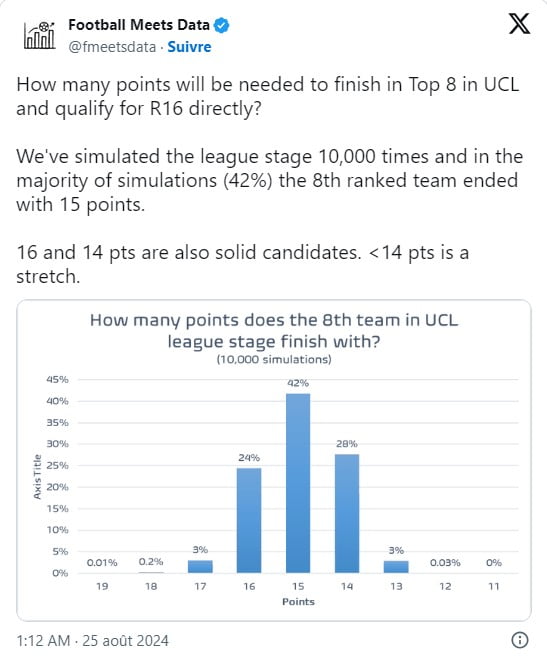The new Champions League format kicked off on 17 September 2024 and has met with mixed reactions. Spectators are divided on whether this format is better than the previous one. This innovative format is quite complex to understand, and without a reference point it’s hard to project yourself. In our opinion, this new format is a good thing, and we explain everything in this article.
The 2024-2025 Champions League format
This year, the Champions League will be expanded from 32 to 36 teams. Instead of groups of 4, we now have a single championship in which all 36 teams are ranked.
Depending on their ranking, the teams will :
- Qualified directly for the round of 16 and seeded for the top 8 in the overall ranking
- Qualified for a play-off to reach the round of 16 for teams ranked 9 to 24
- Be eliminated for teams 25 to 36
Note that for teams 9 to 24, the 8 highest-ranked teams will be seeded for the play-off. So, there will be no play-off between the 9th and 10th-ranked teams for example. What’s more, there will not be any team dropped down to the Europa League, and the number of teams eliminated from any European Cup is now 16 instead of the previous 12.
Because of the number of games, not all 36 teams can play each other. Each team therefore plays a total of 8 games: 4 at home, 4 away. Each of these 8 games is against a different opponent. Above all, and most interestingly, each team plays 2 opponents from each pot, regardless of their original pot.
Take, for example, Manchester City and Red Star Belgrade, who last year had 18 points and 1 point in the group with the greatest final imbalance. This season, Manchester City will face Inter and PSG (Pot 1), Juventus and Club Brugge (Pot 2), Sporting and Feyenoord (Pot 3), Sparta Prague and Slovan Bratislava (Pot 4). Red Star Belgrade will take on Barcelona and Inter (Pot 1), Benfica and AC Milan (Pot 2), PSV and Young Boys (Pot 3) and Stuttgart and Monaco (Pot 4). The level of the draw is therefore the same regardless of the pot.
For the final phase, the table is made in the form of a seeded table without a draw. Everything depends on the ranking during the championship. The top 8 teams are seeded for the final table. They cannot play each other in the round of 16. But more than that, the 1st and 2nd from the regular season cannot play each other before the final because they will each be on one side of the table. As a result, the top 2 in the standings qualify directly for the Round of 16 and also avoid each other until their potential final, and also have a more affordable opponent in the Round of 16 in theory. As far as the games in the final phase are concerned, they will still be two-legged. There are no particular changes compared to previous editions.
We’re in for a real revolution this year with this new format. At FootbAI we hope that the new format will convince the sceptics. This new edition will feature more big games, with clashes between the teams from Pot 1. The intensity and suspense will certainly be there right to the end in a championship where goal difference could be a decisive factor. We have identified eleven positive points for this new format, which you can read about in the following article.
How many points are needed?
The final question we need to answer is how many points will be needed to finish in the top 8 or the top 24. The Football Meets Data team have carried out a calculation based on 10,000 simulations, and according to them, the top 24 should be around 9 points and the top 8 around 15 points. However, it’s not impossible that it could come down to one or even two points more or less, as you can see from their graphs below. Clearly, goal difference could be crucial.


Below is the complete draw for all the games in this championship phase:

Our 11 reasons to like the new Champions League format in this article.
The illustration in this article was generated by Artificial Intelligence using Leonardo AI.
Source :
